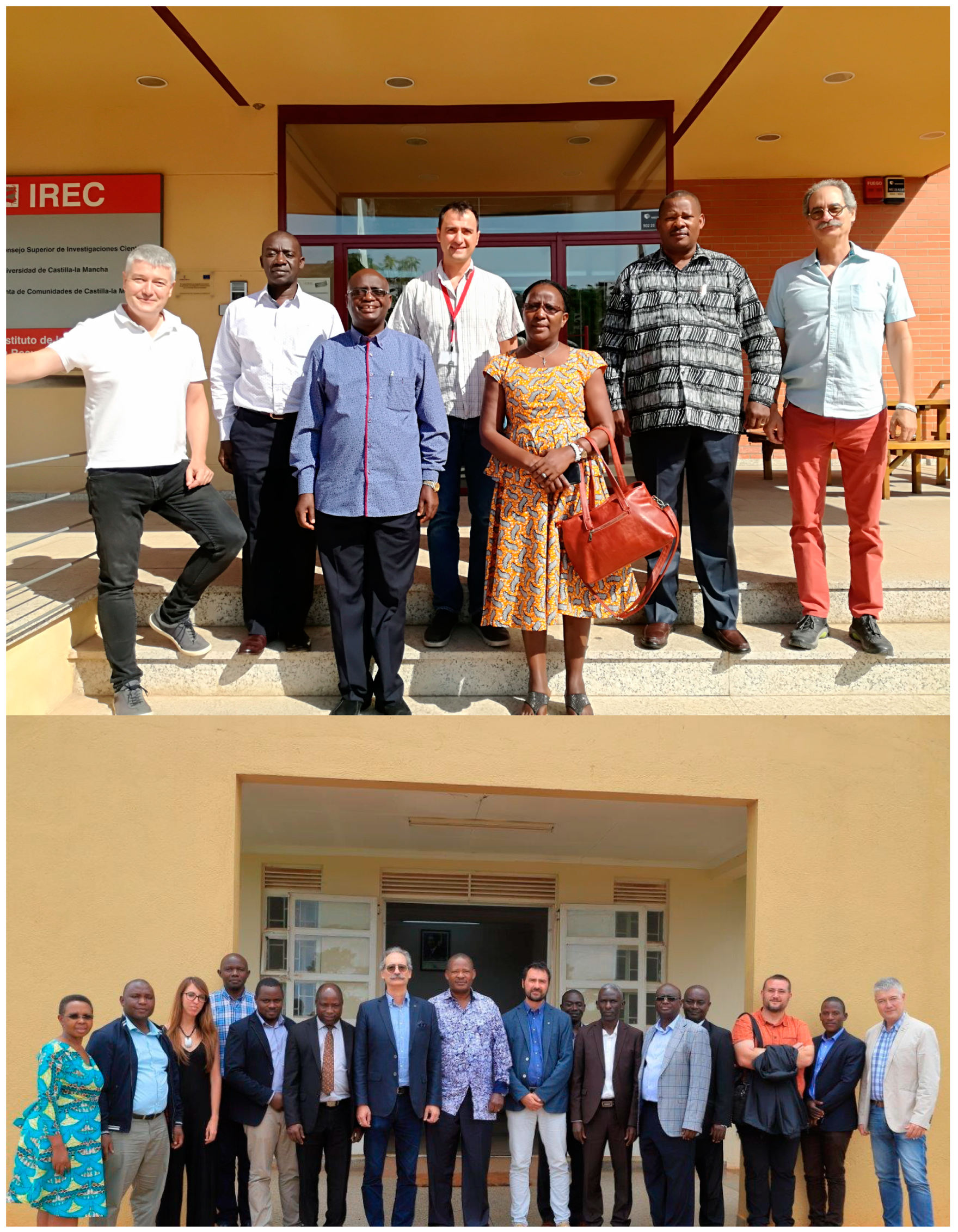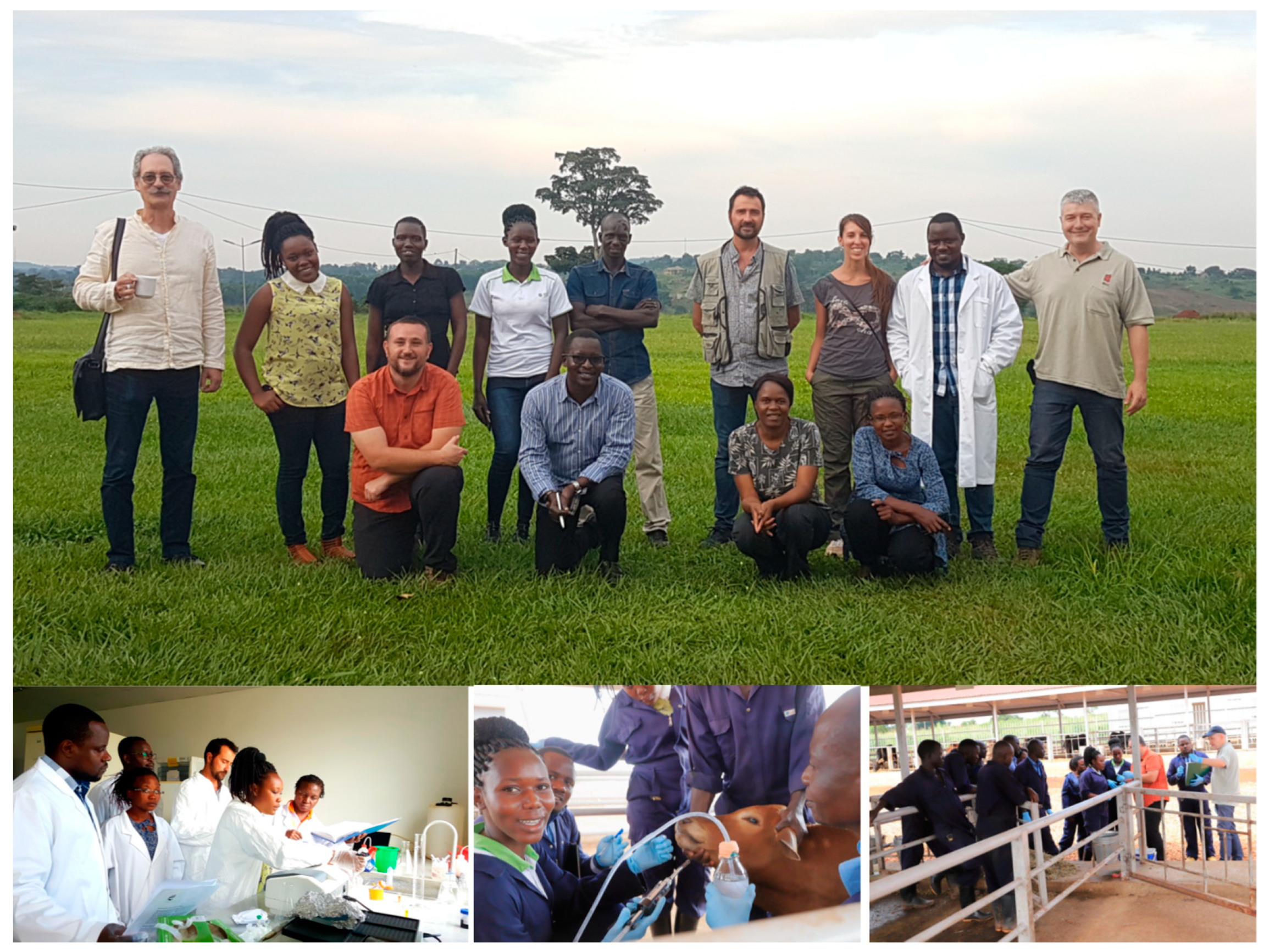Towards a Multidisciplinary Approach to Improve Cattle Health and Production in Uganda
Abstract
1. Ticks and Tick-Borne Diseases in Uganda: The Need for Novel Vaccine Control Interventions
2. Vaccines for the Control of Cattle Tick Infestations in Uganda: An Ongoing Research Project and Future Perspectives
3. The Course: Building Scientific Capacity in Uganda
4. Infections Shared with Cattle: Prospects for Research and Control Interventions
5. Ecology and Epidemiology of Vector-Borne Diseases in Uganda
6. Veterinary Toxicology: Implications for Tick Control and Cattle Production in Uganda
7. Conclusions and Future Directions
Author Contributions
Funding
Acknowledgments
Conflicts of Interest
References
- Tayebwa, D.S.; Vudriko, P.; Tuvshintulga, B.; Guswanto, A.; Nugraha, A.B.; Gantuya, S.; Batiha, G.E.-S.; Musinguzi, S.P.; Komugisha, M.; Bbira, J.S.; et al. Molecular epidemiology of Babesia species, Theileria parva, and Anaplasma marginale infecting cattle and the tick control malpractices in Central and Eastern Uganda. Ticks Tick-Borne Dis. 2018, 9, 1475–1483. [Google Scholar] [CrossRef] [PubMed]
- Gifford-Gonzalez, D. Animal Disease Challenges to the Emergence of Pastoralism in Sub-Saharan Africa. Afr. Archaeol. Rev. 2000, 17, 95–139. [Google Scholar] [CrossRef]
- Okello-Onen, J.; Tukahirwa, E.; Perry, B.; Rowlands, G.; Nagda, S.; Musisi, G.; Bode, E.; Heinonen, R.; Mwayi, W.; Opuda-Asibo, J. The impact of tick control on the productivity of indigenous cattle under ranch conditions in Uganda. Trop. Anim. Health Prod. 2003, 35, 237–247. [Google Scholar] [CrossRef] [PubMed]
- Ocaido, M.; Muwazi, R.T.; Opuda, J.A. Economic impact of ticks and tick-borne diseases on cattle production systems around Lake Mburo National Park in South Western Uganda. Trop. Anim. Health Prod. 2009, 41, 731–739. [Google Scholar] [CrossRef] [PubMed]
- Otim, C.P. Theilriosis in Uganda. In Theileriosis in Eastern, Central and Southern Africa, Proceedings of the Workshop on East Coast Fever Immunization, Lilongwe, Malawi, 20–22 September 1988; Dolan, T.T., Ed.; International Laboratory for Research on Animal Diseases (ILRAD): Nairobi, Uganda, 1989; pp. 29–30. [Google Scholar]
- Republic of Uganda. The presidential technical advisory committee on the tick resistance challenge. In Strategy for Efficient, Effective and Sustainable Management of Ticks, Acaricide Resistance and Tick-Borne Diseases in Uganda; Republic of Uganda: Kampala, Uganda, 2017. [Google Scholar]
- Ocaido, M.; Muwazi, R.T.; Opuda, J.A. Disease incidence in ranch and pastoral livestock herds around Lake Mburo National Park, in South Western Uganda. Trop. Anim. Health Prod. 2009, 41, 1299–1308. [Google Scholar] [CrossRef] [PubMed]
- Mugisha, A.; McLeod, A.; Percy, R.; Kyewalabye, E. Strategies, effectiveness and rationale of vector-borne disease control in the pastoralist system of south-western Uganda. Trop. Anim. Health Prod. 2005, 37, 479–489. [Google Scholar] [CrossRef] [PubMed]
- Mugabi, K.N.; Mugisha, A.; Ocaido, M. Socio-economic factors influencing the use of acaricides on livestock: A case study of the pastoralist communities of Nakasongola District, Central Uganda. Trop. Anim. Health Prod. 2010, 1, 131–136. [Google Scholar] [CrossRef]
- Vudriko, P.; Okwee-Acai, J.; Tayebwa, D.S.; Byaruhanga, J.; Kakooza, S.; Wampande, E.; Omara, R.; Muhindo, J.B.; Tweyongyere, R.; Owiny, D.O.; et al. Emergence of multi-acaricide resistant Rhipicephalus ticks and its implication on chemical tick control in Uganda. Parasites Vectors 2016, 9, 4. [Google Scholar] [CrossRef]
- Vudriko, P.; Okwee-Acai, J.; Byaruhanga, J.; Tayebwa, D.S.; Omara, R.; Muhindo, J.B.; Lagu, C.; Umemiya-Shirafuji, R.; Xuan, X.; Suzuki, H. Evidence-based tick acaricide resistance intervention strategy in Uganda: Concept and feedback of farmers and stakeholders. Ticks Tick Borne Dis. 2018, 9, 254–265. [Google Scholar] [CrossRef]
- FAO in Uganda. Fao, Government of Uganda and Stakeholders Commit to Tackling Tick Vector Related Challenges in Uganda. Ticks, Tick Acaricide Resistance and Tick-Borne Diseases of Livestock in Uganda. Available online: http://www.fao.org/uganda/news/detail-events/fr/c/1151610/ (accessed on 1 October 2019).
- De La Fuente, J.; Almazán, C.; Canales, M.; De La Lastra, J.M.P.; Kocan, K.M.; Willadsen, P. A ten-year review of commercial vaccine performance for control of tick infestations on cattle. Anim. Health Res. Rev. 2007, 8, 23–28. [Google Scholar] [CrossRef]
- De La Fuente, J.; Contreras, M.; Estrada-Peña, A.; Cabezas-Cruz, A. Targeting a global health problem: Vaccine design and challenges for the control of tick-borne diseases. Vaccine 2017, 35, 5089–5094. [Google Scholar] [CrossRef] [PubMed]
- De La Fuente, J.; Contreras, M. Tick vaccines: Current status and future directions. Expert Rev. Vaccines 2015, 14, 1367–1376. [Google Scholar] [CrossRef] [PubMed]
- De La Fuente, J.; Estrada-Peña, A. Why New Vaccines for the Control of Ectoparasite Vectors Have Not Been Registered and Commercialized? Vaccines 2019, 7, 75. [Google Scholar] [CrossRef] [PubMed]
- Almazán, C.; Kocan, K.M.; Bergman, D.K.; Garcia-Garcia, J.C.; Blouin, E.F.; De La Fuente, J. Identification of protective antigens for the control of Ixodes scapularis infestations using cDNA expression library immunization. Vaccine 2003, 21, 1492–1501. [Google Scholar] [CrossRef]
- Artigas-Jerónimo, S.; Villar, M.; Cabezas-Cruz, A.; Valdés, J.J.; Estrada-Peña, A.; Alberdi, P.; De La Fuente, J. Functional Evolution of Subolesin/Akirin. Front. Physiol. 2018, 9, 9. [Google Scholar] [CrossRef]
- Perry, B.; Grace, D. The impacts of livestock diseases and their control on growth and development processes that are pro-poor. Philos. Trans. R. Soc. B Boil. Sci. 2009, 364, 2643–2655. [Google Scholar] [CrossRef]
- Gortázar, C.; Amat, A.C.; O’Brien, D.J. Open questions and recent advances in the control of a multi-host infectious disease: Animal tuberculosis. Mammal Rev. 2015, 45, 160–175. [Google Scholar] [CrossRef]
- Barasona, J.A.; Gortázar, C.; De La Fuente, J.; Vicente, J. Host Richness Increases Tuberculosis Disease Risk in Game-Managed Areas. Microorganisms 2019, 7, 182. [Google Scholar] [CrossRef]
- Byarugaba, F.; Etter, E.M.C.; Godreuil, S.; Grimaud, P. Pulmonary Tuberculosis and Mycobacterium bovis, Uganda. Emerg. Infect. Dis. 2009, 15, 124–125. [Google Scholar] [CrossRef]
- Nalapa, D.P.; Muwonge, A.; Kankya, C.; Olea-Popelka, F. Prevalence of tuberculous lesion in cattle slaughtered in Mubende district, Uganda. BMC Vet. Res. 2017, 13, 73. [Google Scholar] [CrossRef]
- Kazoora, H.B.; Majalija, S.; Kiwanuka, N.; Kaneene, J.B. Prevalence of Mycobacterium bovis skin positivity and associated risk factors in cattle from Western Uganda. Trop. Anim. Health Prod. 2014, 46, 1383–1390. [Google Scholar] [CrossRef] [PubMed]
- Kalema-Zikusoka, G.; Bengis, R.; Michel, A.; Woodford, M. A preliminary investigation of tuberculosis and other diseases in African buffalo (Syncerus caffer) in Queen Elizabeth National Park, Uganda. Onderstepoort J. Vet. Res. 2005, 72, 145–151. [Google Scholar] [CrossRef] [PubMed][Green Version]
- Casal, C.; Infantes, J.A.; Risalde, M.A.; Díez-Guerrier, A.; Domínguez, M.; Moreno, I.; Romero, B.; de Juan, L.; Sáez, J.L.; Juste, R.; et al. Antibody detection tests improve the sensitivity of tuberculosis diagnosis in cattle. Res. Vet. Sci. 2017, 112, 214. [Google Scholar] [CrossRef] [PubMed]
- Contreras, M.; Kasaija, P.D.; Merino, O.; De La Cruz-Hernandez, N.I.; Gortazar, C.; De La Fuente, J. Oral Vaccination with a Formulation Combining Rhipicephalus microplus Subolesin with Heat Inactivated Mycobacterium bovis Reduces Tick Infestations in Cattle. Front. Microbiol. 2019, 9, 45. [Google Scholar] [CrossRef] [PubMed]
- Branagan, D. The feeding performance of the Ixodid Rhipicephalus appendiculatus Neum. on rabbits, cattle and other hosts. Bull. Entomol. Res. 1974, 64, 387–400. [Google Scholar] [CrossRef]
- Yonow, T. The life-cycle of Amblyomma variegatum (Acari: Ixodidae): A literature synthesis with a view to modelling. Int. J. Parasitol. 1995, 25, 1023–1060. [Google Scholar] [CrossRef]
- Horak, I.G.; Heyne, H.; Halajian, A.; Booysen, S.; Smit, W.J. Parasites of domestic and wild animals in South Africa. L. Ixodid ticks infesting horses and donkeys. Onderstepoort J. Vet. Res. 2017, 84, 84. [Google Scholar] [CrossRef]
- Hill, C.M. Farmers’ Perspectives of Conflict at the Wildlife–Agriculture Boundary: Some Lessons Learned from African Subsistence Farmers. Hum. Dimens. Wildl. 2004, 9, 279–286. [Google Scholar] [CrossRef]
- Kukielka, E.A.; Jori, F.; Martínez-López, B.; Chenais, E.; Masembe, C.; Chavernac, D.; Ståhl, K. Wild and Domestic Pig Interactions at the Wildlife–Livestock Interface of Murchison Falls National Park, Uganda, and the Potential Association with African Swine Fever Outbreaks. Front. Vet. Sci. 2016, 3, 34. [Google Scholar] [CrossRef]
- Oura, C.A.L.; Tait, A.; Assimwe, B.; Lubega, G.W.; Weir, W. Theileria parva genetic diversity and haemoparasite prevalence in cattle and wildlife in and around Lake Mburo National Park in Uganda. Parasitol. Res. 2011, 108, 1365–1374. [Google Scholar] [CrossRef]
- Boyle, K.L.; Periyanayagam, U.; Babu, K.M.; Rice, B.T.; Bisanzo, M. Pediatric Poisonings in a Rural Ugandan Emergency Department. Pediatr. Emerg. Care 2017. [Google Scholar] [CrossRef] [PubMed]
- Lunner-Kolstrup, C.; Ssali, T.K. Awareness and Need for Knowledge of Health and Safety among Dairy Farmers Interviewed in Uganda. Front. Public Health 2016, 4, 434. [Google Scholar] [CrossRef] [PubMed]
- Vudriko, P.; Okwee-Acai, J.; Byaruhanga, J.; Tayebwa, D.S.; Okech, S.G.; Tweyongyere, R.; Wampande, E.M.; Okurut, A.R.A.; Mugabi, K.; Muhindo, J.B.; et al. Chemical tick control practices in southwestern and northwestern Uganda. Ticks Tick-Borne Dis. 2018, 9, 945–955. [Google Scholar] [CrossRef] [PubMed]
- Ssemugabo, C.; Halage, A.A.; Neebye, R.M.; Nabankema, V.; Kasule, M.M.; Ssekimpi, D.; Jørs, E. Prevalence, Circumstances, and Management of Acute Pesticide Poisoning in Hospitals in Kampala City, Uganda. Environ. Health Insights 2017, 11, 1178630217728924. [Google Scholar] [CrossRef] [PubMed]
- Dissanayake, V.; Dalka, E.T.; Koh, C.; Bisanzo, M.; Brandt, R.S.; Erickson, T.B.; Chamberlain, S. A pilot study on the management and outcomes of self-poisoning in a rural Ugandan Emergency Centre. Afr. J. Emerg. Med. 2018, 8, 25–28. [Google Scholar] [CrossRef] [PubMed]
- Ogada, D.L. The power of poison: Pesticide poisoning of Africa’s wildlife. Ann. N. Y. Acad. Sci. 2014, 1322, 1–20. [Google Scholar] [CrossRef]
- Kwesiga, B.; Ario, A.R.; Bulage, L.; Harris, J.; Zhu, B.-P. Fatal cases associated with eating chapatti contaminated with organophosphate in Tororo District, Eastern Uganda, 2015: Case series. BMC Public Health 2019, 19, 767. [Google Scholar] [CrossRef]
- Eisler, M.C.; Torr, S.J.; Coleman, P.G.; Machila, N.; Morton, J.F. Integrated control of vector-borne diseases of livestock—Pyrethroids: Panacea or poison? Trends Parasitol. 2003, 19, 341–345. [Google Scholar] [CrossRef]
- Camoni, I.; Ghirotti, M.; De Meneghi, D.; Diverio, S.; Generali, T.; Izzo, P.; Mwaka, B.; Meneghi, D. Chlorfenvinphos residues in milk from traditionally managed cows in Southern Province, Zambia. Vet. Res. Commun. 1990, 14, 503–506. [Google Scholar] [CrossRef]
- Groot, M.J.; Hooft, K.E.V. The Hidden Effects of Dairy Farming on Public and Environmental Health in the Netherlands, India, Ethiopia, and Uganda, Considering the Use of Antibiotics and Other Agro-chemicals. Front. Public Health 2016, 4, 3907. [Google Scholar] [CrossRef]
- Kampire, E.; Kiremire, B.T.; Nyanzi, S.A.; Kishimba, M. Organochlorine pesticide in fresh and pasteurized cow’s milk from Kampala markets. Chemosphere 2011, 84, 923–927. [Google Scholar] [CrossRef] [PubMed]


© 2019 by the authors. Licensee MDPI, Basel, Switzerland. This article is an open access article distributed under the terms and conditions of the Creative Commons Attribution (CC BY) license (http://creativecommons.org/licenses/by/4.0/).
Share and Cite
de la Fuente, J.; Contreras, M.; Kasaija, P.D.; Gortazar, C.; Ruiz-Fons, J.F.; Mateo, R.; Kabi, F. Towards a Multidisciplinary Approach to Improve Cattle Health and Production in Uganda. Vaccines 2019, 7, 165. https://doi.org/10.3390/vaccines7040165
de la Fuente J, Contreras M, Kasaija PD, Gortazar C, Ruiz-Fons JF, Mateo R, Kabi F. Towards a Multidisciplinary Approach to Improve Cattle Health and Production in Uganda. Vaccines. 2019; 7(4):165. https://doi.org/10.3390/vaccines7040165
Chicago/Turabian Stylede la Fuente, José, Marinela Contreras, Paul D. Kasaija, Christian Gortazar, Jose F. Ruiz-Fons, Rafael Mateo, and Fredrick Kabi. 2019. "Towards a Multidisciplinary Approach to Improve Cattle Health and Production in Uganda" Vaccines 7, no. 4: 165. https://doi.org/10.3390/vaccines7040165
APA Stylede la Fuente, J., Contreras, M., Kasaija, P. D., Gortazar, C., Ruiz-Fons, J. F., Mateo, R., & Kabi, F. (2019). Towards a Multidisciplinary Approach to Improve Cattle Health and Production in Uganda. Vaccines, 7(4), 165. https://doi.org/10.3390/vaccines7040165







